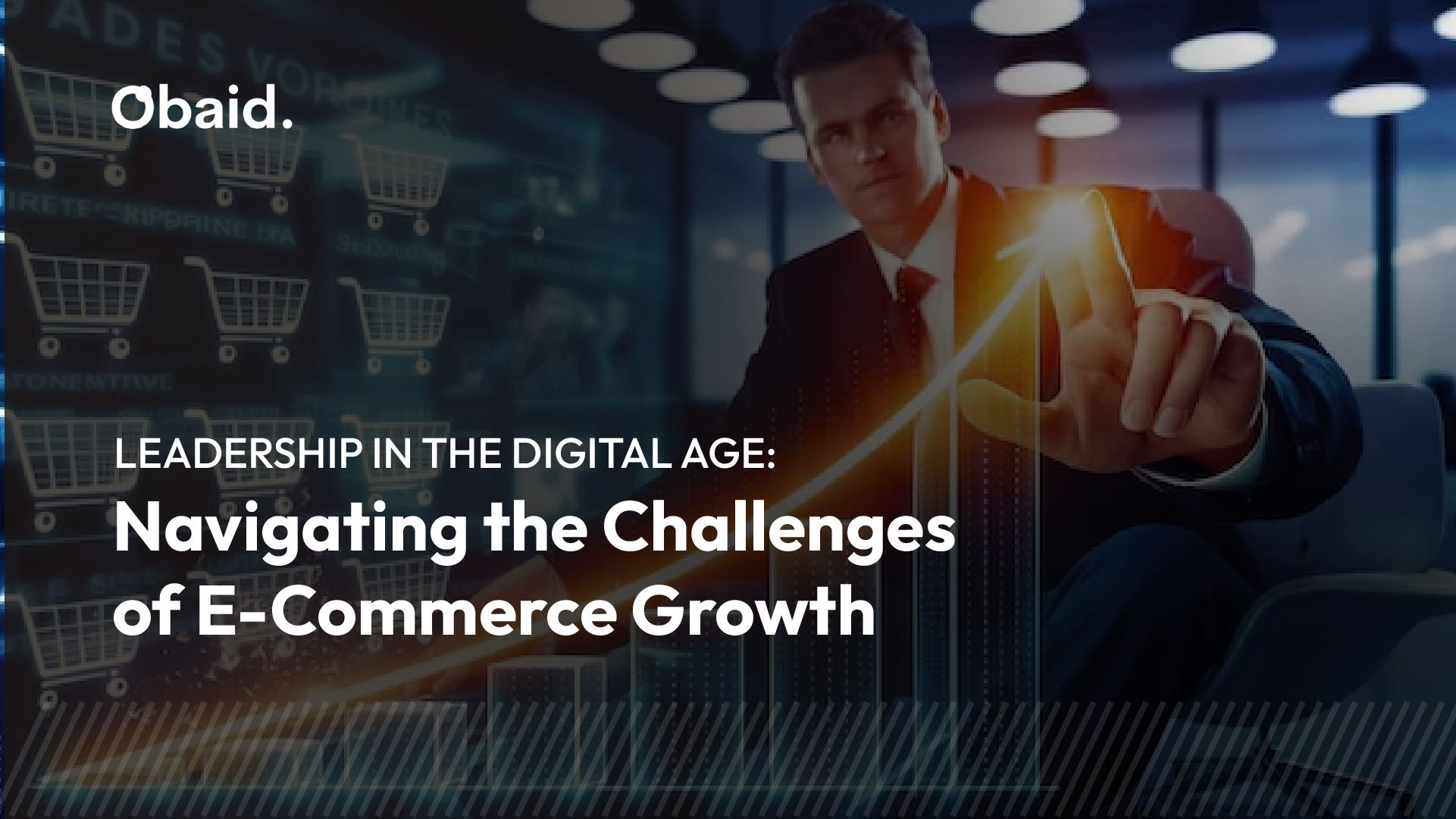Leadership in the Digital Age: Navigating the Challenges of E-Commerce Growth
Published on September 16, 2024

“Your long-term success is not just determined by what you achieve alone, but also by how you empower, engage, support, and elevate your colleagues and teams in the ecosystem around you.”
These words from Carol Cohen, Senior Vice President of Global Talent and Transformation at Cognizant describe the soul of leadership. As the world around us is becoming digital and is evolving so quickly it seems that traditional leadership approaches are not effective anymore. Digital transformation is reshaping how we do business, adding layers of uncertainty and complexity that demand a new kind of leadership i.e. a digital age leadership. Specifically, if we talk about the leadership in e-commerce, it should not just focus on keeping up with technology. The real challenge for leaders lies in handling the complexities it brings while encouraging innovation, supporting teams, and staying flexible in a fiercely competitive e-commerce market.
Transitioning from Traditional to Digital Leadership
Let’s rewind time to the traditional leadership methods when the market was supposed to be stable and evolution was slow and gradual. There leaders make plans for years, setting goals to achieve in the long run. But now in this age of e-commerce adapting to digital change is a complex task that traditional leadership methods cannot meet. Leaders have to be efficient, and quick, must prioritize vision, adaptability, and embrace technological advancements.
Always remember that the transition from traditional to digital leadership is not merely about adopting new tools or platforms. It’s also about fundamentally reshaping how leaders think, act, and engage with their teams. In the digital age, the ability to envision and drive change has become as crucial as technical know-how. Leaders who fail to develop both sets of skills are at the risk of being left behind in the highly competitive and technologically advanced marketplace. As George Westerman, Senior Lecturer, at MIT Sloan said:
“The ability to envision and drive change is just as important as the ability to work with technology. If you don’t have both, you can’t succeed in this world.”
This thought is based on a survey conducted by him on organizations that are digital masters of the time. He revealed that organizations that combine strong leadership capabilities with advanced digital capabilities are successful digital-age leaders.
Key Components and Challenges of Digital Leadership in E-Commerce
Let’s overview the challenges in digital leadership:
Vision and Strategic Thinking
The digital age leaders should have a clear and forward-looking vision. They must know the right use of technology to shape and improve their business effectively. This vision should not be just limited to short-term advantages but should be a long-term planning. Leaders should remain updated about shifts in e-commerce trends in the market, technological disruptions, and ever-changing customer needs so they can instantly build innovative strategies to make their business stand out.
Leadership in e-commerce demands a balance between short-term and long-term goals. Leaders have to be quick in actions to deliver results immediately i.e. increasing sales or improving customer engagement. If he focuses just on short-term outcomes, many opportunities for long-term business growth can be missed. Therefore, to sustain business over time they should be clever enough to maintain an equilibrium between quick wins and investing in future capabilities which include technologies or business models.
The e-commerce market is highly dynamic, with new competitors emerging and consumer preferences shifting rapidly. Leaders must not only predict these changes but also develop strategies to adapt and survive among them. This requires a deep understanding of market trends, customer behaviors, and technological advancements, as well as the agility to pivot when necessary.
Having a clear vision is one thing, but ensuring that the entire organization understands and aligns with this vision is another. One of the most important leadership skills for e-commerce is communication. Leaders must communicate their strategic goals effectively across all levels of the business, encouraging a shared sense of purpose and direction. This can be particularly challenging in large, complex organizations with diverse teams and functions.
Employee Experience and Engagement
Looking after employee experience is one of the core challenges in digital leadership. A special focus is needed on this aspect because a positive employee experience not only enhances overall company performance but also drives innovation and adaptability. Engaged employees are more likely to contribute to the organization’s success and help in managing e-commerce growth.
The rise of remote work and hybrid work models has transformed the traditional workplace. Leaders must find ways to engage and support employees in these new environments, ensuring they have the tools and resources needed to be productive and connected. This includes investing in digital collaboration platforms such as Microsoft Teams, Zoom, Google Workspace, Trello, etc. This helps to make the online meetings easy and develops a strong company culture online Also it is a good way of providing continuous learning opportunities.
Understand and address employee’s pain points as they are the indicators of areas for improvement within a business. However, identifying and addressing these pain points can be challenging, especially in large organizations with diverse workforces. Leaders must implement feedback mechanisms, such as surveys and one-on-one meetings, to understand employee concerns and take action to improve their experience.
Innovative leadership does not just require the incorporation of technologies, leaders must create an environment where employees feel empowered to take risks, experiment, and learn from failure. This involves breaking down silos, encouraging cross-functional collaboration, and recognizing and rewarding innovative ideas.
Customer-Centric Approaches
At the top of e-commerce strategies should be enhancing customer experience. the effective use of customer data using advanced technology helps to create more personalized and meaningful interactions with customers. This helps to develop an emotional connection between a business and its customers. This requires understanding and meeting the individual needs and preferences of customers. However, using this data to take action is a significant challenge. E-commerce leaders must ensure that data is integrated across different systems and platforms, enabling a 360-degree view of the customer. This requires investments in data management software, as well as the skills to analyze and interpret data effectively.
While personalization is essential for creating a strong customer experience, delivering it at scale can be difficult. Automation using AI and machine learning technology to predict customer preferences and purchasing behavior can benefit but human touch should be maintained that will make a big difference.
Data privacy is another challenge faced by leaders in digital age leadership. As customers become more aware of data privacy issues, leaders must handle the delicate balance between personalization and respecting customer privacy. This can be done by being clear about how data is collected, getting customer’s permission before using their data, and strictly following the data protection rules. Failing to do so can break trust and damage the brand’s reputation.
Agility and Adaptability
E-commerce leaders must be able to respond quickly to changes in technology, market conditions, and customer expectations. This requires a flexible mindset, a willingness to embrace change, and the ability to pivot strategies when necessary. Technologies such as AI, IoT, and 5G are advancing at an extraordinary rate, offering new opportunities for value creation in e-commerce. However, staying ahead of these advancements and integrating them effectively into business operations is a significant challenge for leadership in e-commerce.
As Dan Huttenlocher, inaugural dean of the MIT Schwarzman College of Computing, puts it:
“The great advantage of a good business leader or a manager in a company is that they understand their business and their market well. The challenge is also that you understand your business well, so when a new technology comes along, it’s harder to think about how might this technology change the way you do your business.”
This underscores the difficulty leaders face when evaluating new technologies. Leaders must be proactive in exploring new technologies, evaluating their potential impact, and implementing them in ways that align with the organization’s goal. Moreover, adapting to new technologies often requires significant changes in how the organization operates. Leaders must manage this change effectively, ensuring that employees are on board and that the transition is smooth. This involves clear communication, comprehensive training, and continuous support to help employees adapt to new tools and processes.
While innovation is crucial for staying competitive, it can also disrupt existing processes and affect operational efficiency. Leaders must find ways to balance the need for innovation with the need to maintain smooth, efficient operations. This may involve implementing new technologies in phases, continuously monitoring their impact, and making adjustments as needed.
Governance and Ethical Leadership
With the rise of digital technologies comes the need for strong governance and ethical leadership in e-commerce. E-commerce leaders must ensure that their organizations use technology responsibly, maintaining trust with both employees and customers. This includes navigating challenges related to data privacy, cybersecurity, and the ethical use of AI.
Robust cybersecurity measures must be implemented to ensure compliance with data protection regulations and promote a culture of vigilance within the organization. Leaders must also stay informed about emerging threats and adapt their security strategies accordingly.
As technologies like AI become more prevalent, ethical challenges are raised. E-commerce leaders must handle it aptly by ensuring that AI algorithms are transparent, fair, and free from bias, as well as addressing concerns about job displacement and the impact of automation on the workforce. Leaders must take a proactive approach to ethical leadership, setting clear guidelines for the responsible use of technology and engaging in ongoing dialogue with stakeholders. Leaders must be open about how they use technology and data, clearly communicating their policies and practices to employees, customers, and regulators. This involves not only complying with legal requirements but also going beyond them to build trust and credibility with stakeholders.
Continuous Learning and Innovation
With the continuous evolution of technological trends, adapting to digital change has become necessary because what works today may be obsolete tomorrow. E-commerce leaders must encourage their teams to stay curious, experiment, and adapt to new e-commerce growth challenges. This involves keeping up with the latest technological trends, understanding their potential impact, and creating an environment where learning and innovation are valued. Create opportunities for employees to learn new skills, provide access to resources and tools, and recognize and reward learning and innovation.
The pace at which technological change happening makes it difficult for leaders and employees to keep up with it. Leaders must find ways to manage this pace, ensuring that the organization can adapt without becoming overwhelmed. This may involve prioritizing certain initiatives, phasing in new technologies gradually, and providing ongoing support to help employees navigate the changes.
In some organizations, there is a fear of taking risks which prevents them from innovating things. An e-commerce leader can change this by providing a safe space for experimentation. He can encourage his employees to see failure as a learning experience and try again. Leaders should set clear goals for innovation, offer the right support and resources, and promote a collaborative environment where new ideas can grow.
Extract of discussion
Challenges in digital leadership are several. As an e-commerce leader we’re not just guiding our organizations through these changes, we’re also responsible for helping our teams adapt, grow, and flourish in an environment that’s constantly shifting. Our approach should not be just reactive but proactive. It should be not just managing but inspiring, and above all, one that’s deeply human in its focus.

Obaid Arshad
CEO & Co-Founder
